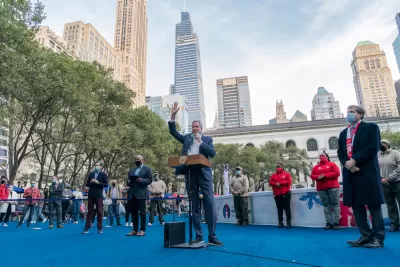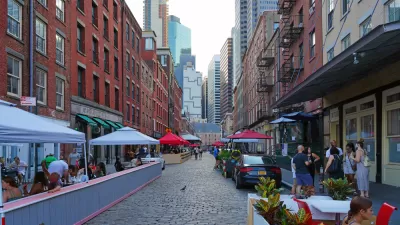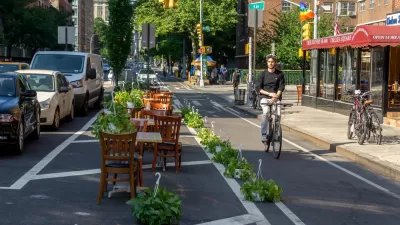Outdoor dining programs have provided relief for local restaurants and retailers, while offering an oasis of social life for residents. The winter months will challenge that momentum, but creative, flexible approaches can save the day again.

With winter fast approaching, commercial corridors suffering from the effects of the pandemic need to be ready to make the most of an already difficult situation. Recent months have shown the success of moving dining outdoors in enlivening main streets everywhere—notably in Center City Philadelphia and across New York City. As the weather gets colder, darker, and wetter, it is time for small businesses and the municipalities supporting them to get even more creative in drawing customers outdoors to eat, drink, and shop. In the coming months, we need to build on the success that dining establishments have had putting tables and chairs on sidewalks and in parking lanes to extend that activity to retailers of all kinds selling their goods both indoors and out (including providing customer pick-up services) and through multiple channels.
The principal lesson we learned from New York’s Open Restaurants initiative is that local government has untapped capacity for supporting small business by being imaginative and flexible about its rules. Allowing restaurants to operate tables in parking lanes and expanded areas in front of and near their storefronts has been a phenomenal success. Laws that have been on the books for decades preventing entrepreneurs from utilizing space heating devices are now being re-evaluated. Cities and towns need to go even further: buying high quality outdoor tables and chairs, as well as heaters, in bulk and distributing them to restaurants that are outside of the city center in order to promote economic activity. We’ve seen once again what we learned in Bryant Park—that food draws people into public spaces. Once we get them there, we need to expand the range of activities and things to buy—especially as the days grow shorter!
There are several key elements to support outdoor commercial activity in winter: First, we need to expand our imaginations as to what is possible. Yes, people will eat outside in cold weather. They do it in Aspen and Zermatt. They will do it on Broadway and Main Street—If we do what they do: provide space heaters and cut the wind. Fast, free public Wi-Fi is essential for drawing and keeping customers and diners downtown. Municipalities should make sure to swap for it as part of its arrangement to provide access to mobile telephone carriers to city infrastructure for carrying 5G transmission equipment.
Great lighting is also essential, and amazing things are possible with recent advances in lighting technology. People actually feel less cold if it’s not dark! Bee lights in trees are only the beginning—and people love them. But take a look at the small town of Caldwell, Idaho and its winter lights festival. What they do there, without fancy technology is nothing short of amazing. My favorite example is the light show on the 12th century tympanum on the façade of the Abbey-Church in the small town of Conques in France. They’ve made an attraction out of a 1,000-year-old architectural ornament using state-of-the-art technology. Cities and towns everywhere can highlight local architecture using light. And there is no reason to turn the lights off after the New Year! Keep them on until the end of February to keep the energy of the event going.
Night markets are a thing. They have the ability to draw thousands of people outdoors, even after dark. Most famous, perhaps, is the Nuremburg Holiday Market in Germany. In New York, the Queens night market has been a wild success in the summer. In the winter, the Bryant Park Winter Village draws huge crowds. With conventional retailing undergoing drastic change, even before the pandemic, the demand for small, flexible, short-term spaces with substantial foot-traffic remains strong everywhere. Most markets have waiting lists. Market vendors are small scale entrepreneurs. In larger places, market venders tend to be recent immigrants. Winter markets have the capacity to generate activity, draw people downtown, and support local entrepreneurial efforts.
The Bryant Park Winter Village also features free skating. Skating is the winter downtown miracle worker from Houston to Edmonton. Every downtown north of the 40th parallel (and many below) should have a downtown skating rink. The technology makes this simpler than it once was—but to be successful skating needs to be well lit and have supporting amenities like food and drink, as well as skate rentals. The lovely downtown skating facility located in Calgary, for example, astoundingly fails to attract users because of a lack of amenities. Cities a little further north should make use of their lakes and rivers, as they do in Winnipeg, Manitoba—creating a unique, difficult to replicate event.
Merchants really need to focus on the quality of their shop windows, as well as how their merchandizing relates to pedestrians. This winter, the usual just won’t do to effectively draw customers to downtowns. Windows also have to feature light and activity. Merchandise should be brought to customers on the sidewalk and at the curb. Shoppers need to be able to shop on-line, either from home or from their mobile devices on the sidewalk right in front of the store.
Restaurants and other commercial corridor small businesses must get creative and win the support of local government to make it through what we hope will be the final months of the COVID-19 pandemic. We all should expand our imaginations as to what is possible and put those imaginations to work to energize public spaces this winter.
Andrew M. Manshel is the author of Learning from Bryant Park: Revitalizing Cities, Towns and Public Spaces (Rutgers University Press, 2020). For ten years Andrew M. Manshel was associate director and counsel at the Bryant Park Restoration Corporation and general counsel and director of Public Amenities to the Grand Central and 34th Street Partnerships. Later, he became executive vice president of Greater Jamaica Development, in Jamaica, Queens. Mr. Manshel blogs about downtown and public space revitalization at theplacemaster.com.

Manufactured Crisis: Losing the Nation’s Largest Source of Unsubsidized Affordable Housing
Manufactured housing communities have long been an affordable housing option for millions of people living in the U.S., but that affordability is disappearing rapidly. How did we get here?

Americans May Be Stuck — But Why?
Americans are moving a lot less than they once did, and that is a problem. While Yoni Applebaum, in his highly-publicized article Stuck, gets the reasons badly wrong, it's still important to ask: why are we moving so much less than before?

Using Old Oil and Gas Wells for Green Energy Storage
Penn State researchers have found that repurposing abandoned oil and gas wells for geothermal-assisted compressed-air energy storage can boost efficiency, reduce environmental risks, and support clean energy and job transitions.

Greening Oakland’s School Grounds
With help from community partners like the Trust for Public Land, Oakland Unified School District is turning barren, asphalt-covered schoolyards into vibrant, green spaces that support outdoor learning, play, and student well-being.

California Governor Suspends CEQA Reviews for Utilities in Fire Areas
Utility restoration efforts in areas affected by the January wildfires in Los Angeles will be exempt from environmental regulations to speed up the rebuilding of essential infrastructure.

Native American Communities Prepare to Lead on Environmental Stewardship
In the face of federal threats to public lands and conservation efforts, indigenous groups continue to model nature-centered conservation efforts.
Urban Design for Planners 1: Software Tools
This six-course series explores essential urban design concepts using open source software and equips planners with the tools they need to participate fully in the urban design process.
Planning for Universal Design
Learn the tools for implementing Universal Design in planning regulations.
Heyer Gruel & Associates PA
City of Moreno Valley
Institute for Housing and Urban Development Studies (IHS)
City of Grandview
Harvard GSD Executive Education
Salt Lake City
NYU Wagner Graduate School of Public Service
City of Cambridge, Maryland





























